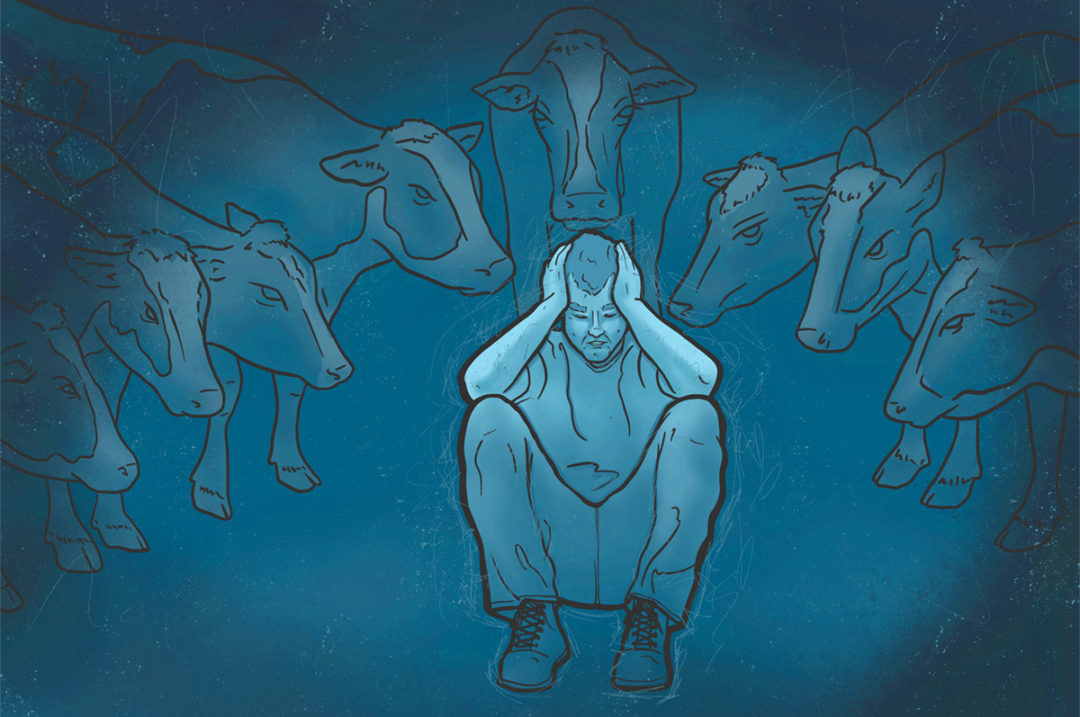Dairy farming is stressful. Milk price fluctuations, labor shortages and equipment breakdowns are problems that can keep a farmer awake at night. Pushing these problems aside to get a good night’s rest may be difficult, but it is necessary.
We are all aware that self care, including quality sleep, affects our mental well-being and emotions. We need our mental sharpness and emotional stability to make safe decisions on the farm. This is especially important when we are working with machinery and cattle.
Handling cattle is one of the most hazardous tasks on a dairy farm. Cattle continuously top the list as the No. 1 or No. 2 cause of injuries reported from dairy worker compensation claims in the U.S. Handling cattle requires patience, a lot of patience.
When we are having a bad day, we lose our patience and our cows notice. In this article, we will take a look at the connection between how we interact with cattle and our safety during these interactions.
Farmer well-being = cow well-being
Before we discuss the link between our behavior and safety during interactions with cattle, I want to share an interesting relationship that exists between farmer well-being and cow well-being. Over 900 dairy farmers participated in a 2019 study that showed that farmers with lower levels of stress and better well-being had cows with better well-being (health, longevity, fertility). This means that if you find effective ways to manage your stress, you and your cows will reap the benefits.
Negative human-cattle interactions and safety
What constitutes a negative human-cattle interaction? This type of interaction occurs when an animal perceives its interaction with a human as unpleasant and distressful. Examples of negative interactions include aversive handling or treatments that cause pain.
Aversive handling methods include using loud noises, hitting, cattle prods or tail twisting to move animals. These types of handling methods can cause cows to become distressed and respond negatively toward the handler. Cows may react by freezing, running or displaying aggressive behaviors.
From your personal experience, you probably understand the added risk of a cow that refuses to move. We typically rely on the flight zone of cattle to safely move cows, but a cow that refuses to move may require vocal or tactile coaxing. One of our go-to methods is to attempt to push the cow forward. However, injuries to the fingers and hands are the most common types of cattle-related injuries on dairies.
What about the cow that is running because of the negative interaction? That cow has now become a safety hazard for you and other dairy workers. A distressed cow is bold enough to charge toward someone blocking an exit.
Although unexpected things happen when handling cattle, some things are not out of your control. Ensuring you stay calm and do not create a distressful situation for the animals will help keep everyone safer.
Positive human-cattle interactions and safety
In most cases, positive human-cattle interactions promote safer future interactions. Heifer calves that received positive interactions with humans grew up to be cows that displayed more favorable behaviors during handling and milking, including less kicking during milking.
On the other hand, calves that were allowed to headbutt humans grew up to be cows that headbutted humans. A headbutt from a full-grown cow feels differently than a headbutt from a 1-month-old calf. Ensure that all employees are on the same page for calf- and cow-handling practices. Calves remember their interactions with humans early on and it shapes how they behave around humans later in life.
Safety rules
Our common safety rules are back and are easily applied to human-cattle interactions.
- Rule No. 1 – Use a “buddy system” when handling cattle, especially those that require additional coaxing.
- Rule No. 2 – Rushed work is not safe work. Cows have a naturally slow pace, so rushing them will only cause distress and a potentially unsafe situation.
- Rule No. 3 – Always be aware of your surroundings. Anyone handling cattle or working near cattle should know their exit plan in case of an emergency. For example, I’m in the holding pen and my normal exit is blocked, what do I do?
Cattle behavior is unpredictable, which is one of the reasons interacting with cattle can quickly go from safe to unsafe. Most cattle-handling training programs teach employees how to move cattle from point A to point B. Take some time to also teach your employees what to do if somewhere between point A and point B something goes wrong. Your employees need to feel comfortable deciding what to do when the unexpected happens.
Being around cattle is often listed as one of the benefits of being a dairy farmer. Some farmers even consider interacting with cattle as therapeutic. Whether it is the cows or not, find what helps you manage your stress. Your well-being is important.







